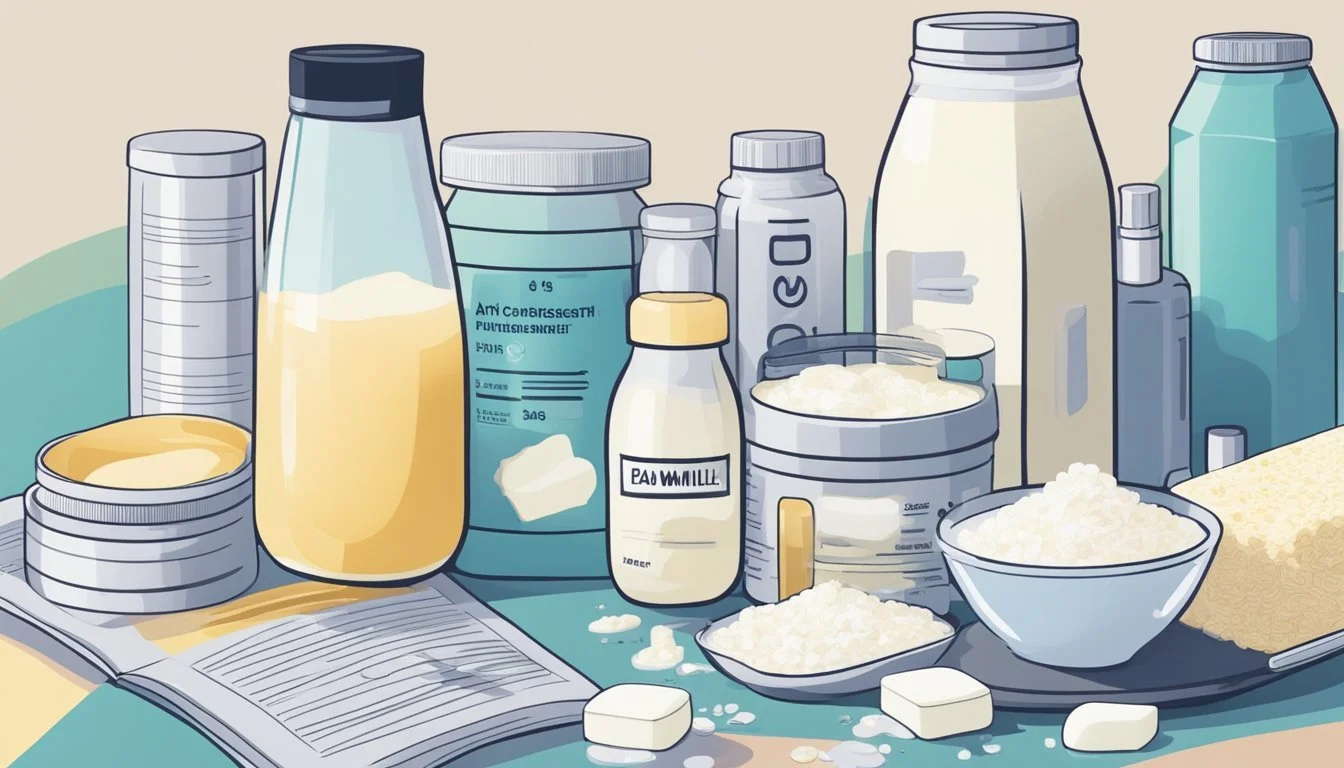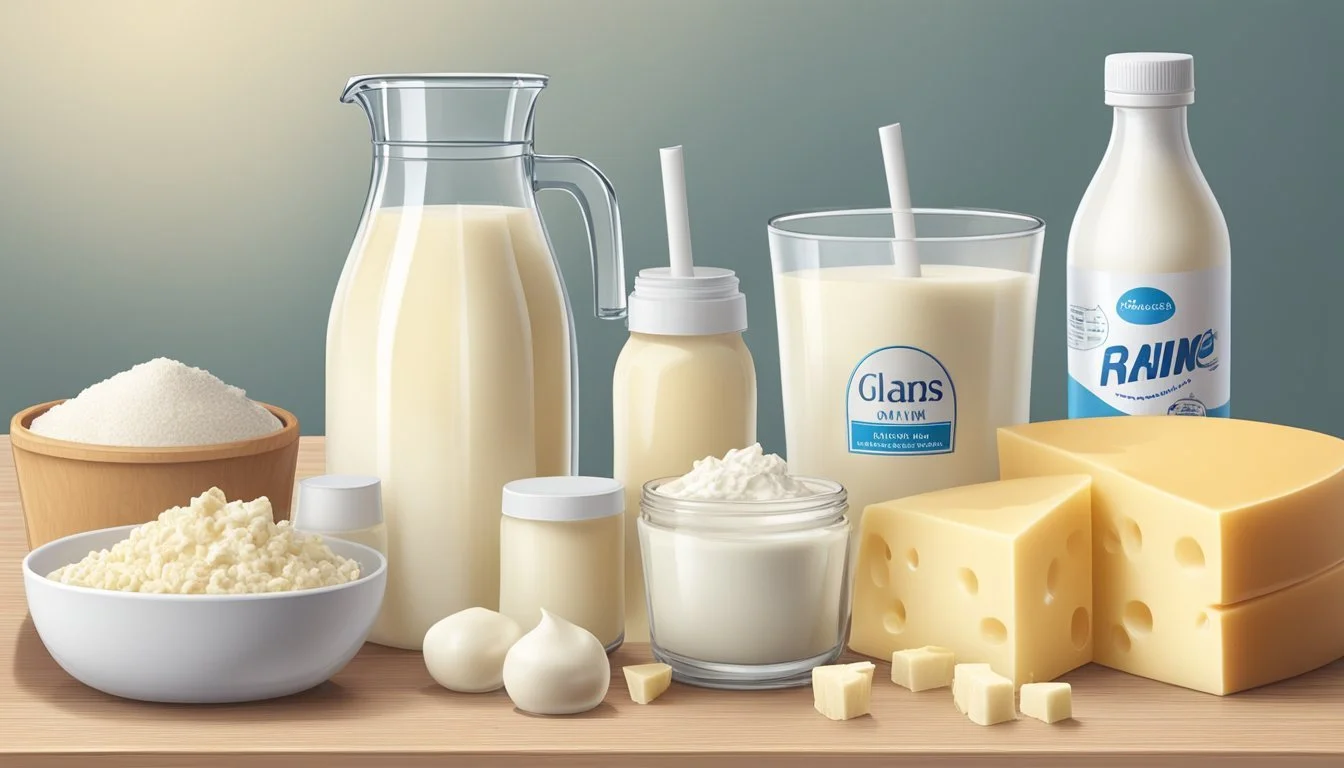Raw Milk and Acne
Analyzing the Evidence Behind Skin Health Claims
The relationship between diet and skin health has long been a subject of interest, with raw milk often being a particular point of focus. While some claim that raw milk can alleviate or even cure acne, others argue that dairy consumption is a contributing factor to breakouts. The debate is fueled by a mix of anecdotal evidence and scientific studies that explore the link between the hormones present in cow's milk and the development of acne.
Sorting through these claims requires a careful look at the body of evidence that examines the role of dairy, and raw milk specifically, in skin health. Milk contains hormones such as insulin-like growth factor (IGF-1), which may influence acne development through pathways that involve inflammation and increased sebum production. On the other hand, proponents of raw milk suggest its natural enzymes and absence of added hormones make it less likely to cause skin issues, emphasizing the importance of the milk being grass-fed and free from antibiotics.
Although there is no consensus on the subject, it remains clear that individual responses to dairy can vary greatly. For some, the consumption of raw milk might contribute to clearer skin due to its probiotic content or a reduced lactose percentage, particularly when it has been fermented. Yet, for others, any form of dairy, raw or processed, has the potential to exacerbate acne, making it a complex issue to navigate. As the scientific community continues to investigate, individuals are encouraged to observe their own skin's reaction to raw milk consumption to draw personal conclusions.
Raw milk has been a subject of interest in the context of acne due to its potential benefits for skin health. While the relationship between raw milk and acne is still being studied, some individuals have reported improvements in their skin conditions after incorporating raw milk into their skincare routine. The natural raw milk enzymes are believed to play a role in promoting healthier skin by aiding in the breakdown of oils and dead skin cells.
Furthermore, the potential benefits of raw milk extend beyond acne, as it has also been associated with promoting dental health. The presence of beneficial nutrients in raw milk can contribute to maintaining healthy teeth and gums, making it a valuable addition to oral care regimens.
When considering raw milk for children, it's important to source it from reputable sources and ensure proper raw milk preservation to maintain its nutritional integrity and safety for consumption.
In conclusion, while further research is needed to fully understand the relationship between raw milk and skin conditions like acne, the potential benefits of raw milk for skin health and dental health make it an intriguing topic for individuals seeking natural skincare and oral care solutions.
Understanding Acne
Acne is a common skin condition that arises due to various factors, including hormonal changes, diet, and skincare practices. Understanding its causes, dietary influences, and treatment options is crucial for effective management.
Causes and Development of Acne
Acne develops when pores in the skin become clogged with dead skin cells and oil. This can lead to the formation of pimples, blackheads, whiteheads, pustules, and, in severe cases, cysts. Several factors contribute to the occurrence of acne:
Hormonal fluctuations, which can increase oil production in the skin
Genetics, which can dictate one's predisposition to acne
Use of certain medications, which can alter skin and hormone conditions
Stress, affecting hormones and immune response
It is a multifactorial condition, with no single cause applicable to all individuals.
Acne and Diet: Establishing the Link
The relationship between diet and acne is complex and has been a topic of research and debate. Studies suggest that certain foods may exacerbate acne in predisposed individuals. These include:
High-glycemic index foods that may spike insulin levels, potentially increasing oil production
Dairy, especially skim milk, which could be implicated due to hormones present in milk
However, it is important to note that dietary effects on acne can vary greatly between individuals.
Acne Treatments and Prevention
Treatment and prevention strategies for acne are tailored to the severity and type of acne. Options include:
Topical treatments, such as benzoyl peroxide or salicylic acid, targeting bacteria and reducing oil
Oral medications, like antibiotics or isotretinoin, for more severe cases
Lifestyle modifications, including a balanced diet and proper skin care to reduce oil and dead skin buildup
Preventive measures include gentle cleansing and avoiding known triggers. It is advisable to consult a dermatologist for a personalized treatment plan.
The Science of Milk and Dairy Products
Dairy products, derived from milk, are diverse and complex in their nutritional makeup, varying in both composition and health impacts depending on their processing.
Composition of Milk and Its Derivatives
Milk, regardless of being pasteurized or raw, primarily consists of water, lactose, fats, proteins including casein and whey, and a variety of vitamins and minerals. Whey proteins, which are a byproduct of cheese production, are particularly known for their high-quality amino acid profile. The exact composition of milk can vary depending on the animal breed, feed, and stage of lactation.
Water: The largest component of milk, typically around 87%.
Lactose: A sugar accounting for about 4-5% of cow's milk.
Fats: Milk fat can constitute 3-4% of whole milk.
Proteins: Approximately 3.2% of cow’s milk, with casein being the major type.
Vitamins and Minerals: Including vitamins A, D, and B12, as well as minerals such as calcium and phosphorus.
Nutritional Value of Dairy
Dairy products are known for their nutritional benefits, offering an abundant source of calcium and phosphorus which are essential for bone health. They also provide important vitamins like vitamin A, B12, and D, and are rich in proteins that are crucial for tissue repair and muscle growth.
Calcium: Essential for healthy bones and teeth.
Vitamin D: Facilitates absorption of calcium and phosphorus from the digestive tract.
Proteins: Vital for various bodily functions including the development and repair of tissues.
Vitamins A and B12: Important for vision, immune function, and red blood cell formation.
Differences Between Pasteurized and Raw Milk
The primary difference between pasteurized and unpasteurized milk lies in the treatment process to render the milk safe from harmful bacteria. Pasteurization involves heating milk to a specific temperature for a set period, effectively killing most bacteria without significantly altering the nutritional content. Raw milk, while it may still contain beneficial bacteria and enzymes, poses a risk of harboring pathogens such as Salmonella, E. coli, and Listeria.
Pasteurized Milk:
Bacteria: Most harmful bacteria are destroyed.
Nutrition: Largely preserved, with slight losses in vitamins.
Raw Milk:
Bacteria: Can be a source of beneficial enzymes, but risk of pathogens exists.
Nutrition: May contain slightly higher levels of certain vitamins.
Health Risks Associated with Raw Milk
Consuming raw milk can lead to serious health implications due to the presence of harmful pathogens. The Centers for Disease Control and Prevention (CDC) reports numerous cases of foodborne illnesses directly linked to raw milk consumption.
Foodborne Illnesses from Raw Milk
Raw milk is susceptible to contamination from foodborne pathogens that can cause illness in humans. According to the CDC, individuals who consume raw milk risk exposure to bacteria such as Salmonella, E. coli, and Campylobacter. These organisms not only cause gastrointestinal discomfort but can lead to severe and life-threatening conditions.
Salmonella: Causes symptoms like fever, diarrhea, and abdominal cramps.
E. coli: Can result in diarrhea, with certain strains leading to kidney failure.
Campylobacter: Associated with diarrhea, abdominal pain, and fever.
Microorganisms and Infections
The risk of infection from raw milk is particularly high for individuals with weakened immune systems, such as the elderly, young children, and those with chronic illnesses. These infections can result in hospitalizations and, in severe cases, death.
Common infections from raw milk include:
Tuberculosis
Listeriosis
Brucellosis
Vulnerable groups:
Pregnant women
Young children
The elderly
Immune-compromised individuals
Raw Milk Controversies in the United States
In the United States, the sale of raw milk is subject to state regulations, and its legal status varies. Outbreaks related to raw milk are more common in states where it is more readily available. The public health community generally supports pasteurization as a critical step to protect the population from milk-related outbreaks.
Legislation varies by state:
Some states ban the sale completely.
Others allow sales in retail stores or directly on farms.
The CDC associates fewer outbreaks with states that have stricter regulations.
Public health officials continue to monitor and report on the risks associated with raw milk consumption, emphasizing the potential for serious health outcomes.
Regulations and Safety Measures
The safety and regulation of milk consumption are paramount to public health, with the pasteurization process and state laws playing critical roles. Both entities enforce guidelines to ensure milk is safe for consumption.
Pasteurization Process and Public Health
Pasteurization is a process that heats milk to a specific temperature for a set period to kill harmful bacteria. This process is essential for protecting public health, as it significantly reduces the risk of foodborne illnesses. The Food and Drug Administration (FDA) mandates the pasteurization of milk to be sold across state lines. The key steps in ensuring the safety of pasteurized milk include:
Clean: Milk must be sourced from well-maintained areas to avoid contamination.
Chill: Prompt cooling is necessary to slow bacterial growth.
Cook: Milk is pasteurized by heating to at least 161 degrees Fahrenheit for 15 seconds or to 145 degrees for 30 minutes for batch pasteurization.
State Laws and Raw Milk Sales
State laws on the sale of raw milk vary significantly across the United States. While some states permit the sale of raw milk directly to the consumer, others have strict bans on its sale due to health risks associated with raw, unpasteurized milk. Entities such as state health departments often collaborate with the FDA to create regulations that manage the production and distribution of raw milk within their jurisdictions. They implement safety measures which may include:
Regular inspections of dairy farms
Testing milk samples for bacterial contamination
Enforcing strict sanitation and storage protocols
These regulations are designed to ensure consumer safety while allowing some level of raw milk consumption where it is legal.
The Impact of Dairy on Acne
Investigations into the role of dairy in the development of acne have yielded varied results, drawing attention to the association between dairy consumption and the severity of skin breakouts. The interest in this relationship is anchored in the hypothesis that certain components found in dairy may play a part in exacerbating this common skin condition.
Examining the Evidence: Dairy and Skin Breakouts
Evidence from both observational studies and controlled trials suggests there may be an association between dairy intake and an increased risk of acne. In particular, a meta-analysis that reviewed data from 78,529 children, adolescents, and adults found a positive correlation between the consumption of dairy products—especially milk—and the occurrence of acne vulgaris. This reinforces the claim that components in milk might influence the development of skin breakouts.
Observational Data: Show a link between dairy and increased acne severity.
Controlled Trials: Provide insight into the potential causative relationship.
Potential Allergens in Milk That May Affect Acne
Milk contains proteins such as casein and whey, which can act as allergens for certain individuals. In the context of acne, these allergens may contribute to inflammation and subsequent skin eruptions. Those with a known lactose intolerance or milk allergies are particularly prone to experiencing symptoms, including acne, which may be attributed to an immune response elicited by these allergens.
Proteins: Casein and whey can provoke an allergic reaction, influencing acne development.
Lactose Intolerance: May exacerbate skin conditions due to an immune response.
Hormonal Aspects: Dairy Intake and Acne Severity
Dairy products, particularly milk, can impact hormonal levels in the body due to the presence of growth hormones and substances that act like IGF-1 (insulin-like growth factor 1), which is known to influence sebum production and exacerbate acne. The external hormones found in milk may interact with an individual's own hormones, potentially increasing the severity of acne and contributing to this health issue.
IGF-1: Can raise sebum production, worsening acne.
Hormonal Fluctuations: Influenced by external hormones in dairy, potentially affecting acne severity.
The consumption of dairy products has been under scrutiny concerning its influence on acne. While correlations have been drawn by multiple studies, individual responses to dairy products may vary, emphasizing the complexity of acne as a multifactorial health issue.
Raw Milk as an Alternative
In evaluating raw milk as an alternative, consumers weigh perceived health benefits against safety concerns. This section explores the complex landscape of raw milk consumption, addressing myths versus facts, how to source raw milk safely, and the rationale behind the natural diet argument.
Benefits and Myths
Benefits:
Some consumers believe that raw milk from healthy, grass-fed cows can offer a richer nutritional profile than pasteurized milk, including a higher content of certain vitamins and enzymes.
Proponents also suggest that raw milk may contain probiotics that contribute to a healthier gut microbiome.
Myths:
A common misconception is that raw milk can cure or prevent diseases, which lacks scientific substantiation.
The claim that pasteurization significantly depletes the nutritional value of milk is often overstated.
Choosing Safe Raw Milk Sources
When considering raw milk, the choice of source is critical to mitigate health risks. To minimize the chance of contamination from pathogens such as bovine tuberculosis or bacteria causing mastitis, employ the following precautions:
Research the farm: Ensure it tests its milk and maintains high standards of hygiene.
Check the animals: They should be grass-fed cows and exhibit no signs of illness.
Farmers markets: If purchasing from farmers markets, ask vendors about their safety protocols and animal health.
Raw Milk and the Natural Diet Argument
The argument for raw milk as part of a natural diet contends that it is a more authentic form of milk closer to what humans historically consumed. Supporters posit:
Unprocessed: Raw milk comes directly from the cow without undergoing pasteurization.
Historical consumption: Before industrialization, humans consumed milk directly from healthy animals without significant health issues related to the practices of the time.
Dairy Substitutes and Acne
Exploring alternatives to dairy is essential for individuals managing acne who may have dairy intolerance or want to avoid milk products. The relationship between acne and various dairy substitutes, as well as the significance of probiotics in this context, is vital to understand.
Non-Dairy Alternatives
Non-dairy alternatives have grown in popularity as potential options for those with lactose intolerance and acne concerns. These alternatives include almond milk, rice milk, coconut milk, and others, each with a distinct nutritional profile. For example:
Almond milk: Low in calories and lacks whey proteins, making it suitable for lactose-intolerant individuals.
Coconut milk: High in healthy fats and does not contain lactose, but it may be comedogenic for some individuals due to its oil content.
Rice milk: The least allergenic of all milk alternatives, although often high in carbohydrates.
It is important to note that while these milk alternatives do not contain lactose, their effects on acne can vary. Choosing unsweetened varieties is advisable to avoid added sugars that could potentially exacerbate acne.
The Role of Probiotics in Acne and Dairy Intolerance
The presence of probiotics in certain dairy products like yogurt and kefir suggests a potential benefit for acne sufferers due to their ability to balance gut microorganisms. Specific strains of probiotics found in these fermented dairy options have been observed to diminish inflammatory responses associated with acne. For those who avoid dairy, probiotic supplements might be considered to maintain a healthy microbiome.
For individuals with dairy intolerance, it is crucial to look for non-dairy fermented foods or supplements containing live cultures to integrate probiotics into their diet. Controlled intake of probiotics may aid in reducing inflammation from acne and improve digestion, which could be beneficial for those who are intolerant to dairy.
Case Studies and Research
In the exploration of the relationship between dairy consumption and acne, a plethora of case studies and scientific inquiries provide insight. These range widely from meta-analyses synthesizing data across studies to controlled clinical trials examining the direct impacts of dairy intake.
Meta-Analyses of Dairy Consumption and Acne
Meta-analyses compile and analyze findings from various studies to determine overarching trends and potential relations between dairy intake and acne. For instance, a comprehensive meta-analysis reviewing 78,529 children, adolescents, and young adults found a positive association between dairy consumption and the risk of acne. Specifically, it was observed that consumption of any dairy, notably skim milk, was correlated with a higher incidence of the skin condition. Another meta-analysis reported a slightly increased risk for moderate-to-severe acne in relation to milk consumption, while mild acne appeared not to be significantly influenced by dairy intake.
Evidence Highlights from Meta-Analyses:
Observational study data reviewing up to 78,529 individuals show a positive correlation between dairy and acne.
Subgroups such as individuals with moderate-to-severe acne demonstrate a consistent positive association with milk consumption.
Clinical Trials and Dairy Intake
Clinical trials serve as a primary source of evidence by directly assessing the effects of dairy on acne development through controlled environments. These trials often introduce or eliminate dairy from diets of participants to identify potential changes in acne severity. However, clinical trial findings can vary due to different study designs, dairy products studied, and participant characteristics. For example, a trial tackling skim milk specifically reported an association with acne prevalence, whereas other studies examining full-fat or low-fat milk did not show a significant link. These varied outcomes highlight the complexity of determining the effects of dairy on acne and suggest that factors such as fat content in milk could play a role.
Key Findings from Clinical Trials:
Skim milk consumption has been associated with an increase in acne.
Full-fat and low-fat milk have not shown a consistent relationship with acne severity in clinical trials.







